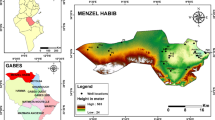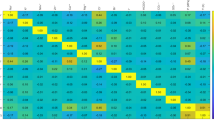Abstract
The mineral resource estimation requires accurate prediction of the grade at location from limited borehole information. It plays the dominant role in the decision-making process for investment and development of various mining projects and hence become an important and crucial stage. This paper evaluvates the use of two distinct artificial neural network (ANN)-based models, general regression neural network (GRNN) and multilayer perceptron neural network (MLP NN), to improve the grade estimation from Koira iron ore region in Sundargarh district, Odisha. ANN-based models capture the inherent complex structure of mineral deposits and provide a reliable generalization of the iron grade. The ANN-based approach does not require any preliminary geological study and is free from any statistical assumption on the raw data before its application. The GRNN is a one-pass learning algorithm and does not require any iterative procedure for training less complex structure and requires only one learning parameter for optimization. In this investigation, the spatial coordinates and multiple lithological units were taken as input variables and the iron grade was taken as the output variable. The comparative analysis of these models has been carried out and the results obtained were validated with traditional geostatistical method ordinary kriging (OK). The GRNN model outperforms the other methods, i.e. MLP and OK, with respect to generalization and predictability of the grades at an un-sampled location.











Similar content being viewed by others
References
Arpat G, Caers J (2007) Conditional simulation with patterns. Math Geology 39(2):177–203
Bardossy GY, Fodor J (2001) Traditional and new ways to handle uncertainty in geology. Nat Resour Res 10(3):169–187
Bey NF, Royer JJ, Cheng LZ, Erchiqui F, Mareschal JC (2013),” Neural network stochastic simulation applied for quantifying uncertainties”, International Journal of Multiphysics, Vol. 7
Chatterjee S, Bhattacherjee A, Samanta B, Pal SK (2006) “Ore grade estimation of a limestone deposit in India using an artificial neural network”, Applied GIS, Vol. 2
Chatterjee S, Bandopadhyay S, Ganguli R, Bhattacherjee A, Samanta B, Pal SK (2007) General regression neural network residual estimation for ore grade prediction of limestone deposit. Min Technol 116(3):89–99
Chatterjee S, Bandopadhyay S, Machuca D (2010) Ore grade prediction using a genetic algorithm and clustering based ensemble neural network model. Math Geosci 42:309–326
Chen AS, Leung MT (2004) Regression neural network for error correction in foreign exchange forecasting and trading. Comput Oper Res 31:1049–1068
Chiles JP, Delfiner P (1999) Geostatistics modelling spatial uncertainty. Wiley-Interscience, New York, p 720
Cigizoglu H. K., Murat A. (2006), “Generalized regression neural network in modelling river sediment yield”, Advances in Engineering Software, Vol. 37, pp. 63–68
David M (1977) Geostatistical ore reserve estimation. Elsevier Scientific Publishing, Amsterdam
Deutsch CV, Journel AG (1998) GSLIB: geostatistical software library and user’s guide, Edition: 2 edn. Oxford University Press, New York, p 369
Dutta S, Mishra D, Ganguli R, Samanta B, Bandopadhyay S (2006) A hybrid ensemble model of kriging and neural network for ore grade estimation. Int J Min Reclam Environ 20(1):33–45
Dutta S, Bandopadhyay S, Ganguli R, Misra D (2010) Machine learning algorithms and their application to ore reserve estimation of sparse and imprecise data. J Intell Learn Syst Appl 2:86–96
Firat M, Gungor M (2009) Generalized regression neural networks and feed forward neural networks for prediction of scour depth around bridge piers. Adv Eng Softw 40:731–737
Goovaerts P (1997) Geostatistics for natural resources evaluation. Oxford University Press, New York, p 483
Hyun J, Saro L (2010) Application of artificial neural network for gold–silver deposits potential mapping: a case study of Korea. Nat Resour Res 19(2):103–124
Journel AG, Huijbregts C (1978) “Mining geostatistics”, London, Academic Press, pp. 600
Kanevski M, Parkin R, Pozdnukhov A, Timonin V, Maignan M, Demyanov V, Canu S (2004) Environmental data mining and modeling based on machine learning algorithms and geostatistics. Environ Model Softw 19:845–855
Kapageridis IK (2002) “Grade Interpolation Using Radial Basis Function Networks” 11th International Symposium on Mine Planning and Equipment Selection (MPES 2002), VSB - Technical University of Ostrava, Prague
Kapageridis IK (2005) Input space configuration effects in neural network-based grade estimation. Comput Geosci 31:704–717
Ke J (2002) .Neural-network modelling of placer ore grade spatial variability. Dissertation, University of Alaska, Fairbanks
Kisi O (2006) Generalized regression neural networks for evapotranspiration modelling. Hydrol Sci J 51(6):1092–1105
Koike K, Matsuda S, Suzuki T, Ohmi M (2002) Neural network-based estimation of principal metal contents in the Hokuroku District, Northern Japan, for exploring Kuroko-type deposits. Nat Resour Res 11(2):135–156
Leung MT, Chen A, Daouk H (2000) Forecasting exchange rates using general regression neural networks. Comput Oper Res 27:1093–1110
Li X, Yu-ling X, Qian-jin G, Li-hong L (2010) Adaptive ore grade estimation method for the mineral deposit evaluation. Math Comput Model 52:1947–1956
Li J, Heap AD, Potter A, Daniell JJ (2011) Application of machine learning methods to spatial interpolation of environmental variables. Environ Model Softw 26:1647–1659
Li XL, Li LH, Zhang BL, Guo QJ (2013) Hybrid self-adaptive learning based particle swarm optimization and support vector regression model for grade estimation. Neurocomputing 118:179–190
Luo X, Bandopadhyay S (2003) Data-driven fuzzy analysis in quantitative mineral resource assessment. Comput Geosci 29:3–13
Mahmoudabadi H, Mohammad I, Mohammad BM (2009) A hybrid method for grade estimation using genetic algorithm and neural networks. Comput Geosci 13:91–101
Mehdi B, Saeed A, Masoud SP (2011) The application of median indicator kriging and neural network in modeling mixed population in an iron ore deposit. Comput Geosci 37:530–540
Misra D., Samanta B., Dutta S., Bandopadhyay S. (2007), “Evaluation of artificial neural networks and kriging for the prediction of arsenic in Alaskan bedrock-derived stream sediments using gold concentration data”, Int J Min Reclam Environ, Vol. 21:4, pp. 282–294
Mustapha H, Dimitrakopoulos R (2010) Conditional simulation of complex geological patterns using higher order multi-point spatial cumulants. Math Geosci 42(5):455–473
Osamah AA, Garrouch AA (2015) “A general regression neural network model offers reliable prediction of CO2 minimum miscibility pressure”, J Petrol Explor Prod Technol
Roy I, Sarkar BC (2005) “A geostatistical approach to resource evaluation of Kalta Iron Ore Deposit, Sundargarh district,Orissa”, Journal of the geological society of India
Samanta B (2010) Radial basis function network for ore grade estimation. Nat Resour Res 19(2):91–102
Samanta B, Bandopadhyay S (2009) Construction of a radial basis function network using an evolutionary algorithm for grade estimation in a placer gold deposit. Comput Geosci 19(2):1592–1602
Samanta B, Bandopadhyay S, Ganguli R (2004) Sparse data division using data segmentation and Kohonen Network for neural network and geostatistical ore grade modeling in Nome offshore placer deposit. Nat Resour Res 13(3):189–200
Samanta B, Ganguli R, Bandopadhyay S (2005) Comparing the predictive performance of neural networks with ordinary kriging in a bauxite deposit. Min Technol 114:129–139
Samanta B, Bandopadhyay S, Ganguli R (2006) Comparative evaluation of neural network learning algorithms for ore grade estimation. Math Geol 38(2):175–197
Shahoo M, Ramazia HR, Moradi S (2014) Estimation of iron concentration by using a support vector machine and an artificial neural network—the case study of the Choghart deposit southeast of Yazd, Yazd, Iran. Geopersia 4(2):201–212
Singer AD, Kouda R (1996) Application of a feedforward neural network in the search for Kuroko deposits in the Hokuroku district, Japan. Math Geol 28(8):1017–1023
Singer AD, Kouda R (1997) Classification of mineral deposits into types using minerology with a probabilistic neural network. Nonrenewable Sources 6:27–32
Specht D (1991) A general regression neural network. IEEE Trans Neural Netw 2(6):568–576
Strebelle S (2002) Conditional simulation of complex geological structures using multiple point geostatistics. Math Geol 34(1):1–22
Tahmasebi P, Hezarkhani A (2009) “Application of optimized neural network by genetic algorithm”, IAMG 09. Stanford University, California
Tahmasebi P, Hezarkhani A (2010) Comparison of optimized neural network with fuzzy logic for ore grade estimation. Aust J Basic Appl Sci 4(5):764–772
Tahmasebi P, Hezarkhani A (2011a) Application of a modular feed forward neural network for grade estimation. Nat Resour Res 20(1):25–32
Tahmasebi P, Hezarkhani A (2011b) Application of adaptive neuro-fuzzy inference system for grade estimation; case study, Sarcheshmeh porphyry copper deposit, Kerman, Iran. Aust J Basic Appl Sci 4(3):408–420 2010
Tahmasebi P, Hezarkhani A (2012) A hybrid neural networks-fuzzy logic-genetic algorithm for grade estimation. Comput Geosci 42:18–27
Tahmasebi P, Sahimi M (2015) Geostatistical simulation and reconstruction of porous media by a cross-correlation function and integration of hard and soft data. Transp Porous Med 107:871–905
Tahmasebi P, Sahimi M (2016a) Enhancing multiple-point geostatistical modeling: 1. Graph theory and pattern adjustment. Water Resour Res 52:2074–2098
Tahmasebi P, Sahimi M (2016b) Enhancing multiple-point geostatistical modeling: 2. Iterative simulation and multiple distance function. Water Resour Res 52:2099–2122
Tahmasebi P, Hezarkhani A, Sahimi M (2012) Multiple-point geostatistical modeling based on the cross-correlation functions. Comput Geosci 16:779–797
Timonin V, Savelieva E (2005) Spatial prediction of radioactivity using general regression neural network. Appl Gis 1(2):1–14
Tomandal D, Schober A (2001) Modified general regression neural network (MGRNN) with new, efficient training algorithms as a robust black box tool for data analysis. Neural Netw 14:1023–1034
Wu X, Zhou Y (1993) Reserve estimation using neural network techniques. Comput Geosci 19(4):567–575
Wu J, Zhang T, Journel A (2008) Fast filtersim simulation with score-based distance. Math Geosci 40(7):773–788
Yama BR, Lineberry GT (1999) Artificai neural network application for a predictive yask in mining. Min Eng 51(2):59–64
Yingwei L, Sundararajan N, Saratchandran P (1998) Performance evaluation of a sequential minimal radial basis function (RBF) neural network learning algorithm. IEEE Tran Neural Netw 9(2):308–318
Zhang T, Switzer P, Journel A (2006) Filter-based classification of training image patterns for spatial simulation. Math Geol 38(1):63–80
Acknowledgements
First author expresses gratitude to Prof. S. Chhatterjee Assistrant professor, Department of Geological and Mining Engineering and Sciences, Michigan Tech., USA for initiation and guidance during the initial stage of investigation.
Author information
Authors and Affiliations
Corresponding author
Rights and permissions
About this article
Cite this article
Goswami, A.D., Mishra, M.K. & Patra, D. Investigation of general regression neural network architecture for grade estimation of an Indian iron ore deposit. Arab J Geosci 10, 80 (2017). https://doi.org/10.1007/s12517-017-2868-5
Received:
Accepted:
Published:
DOI: https://doi.org/10.1007/s12517-017-2868-5




